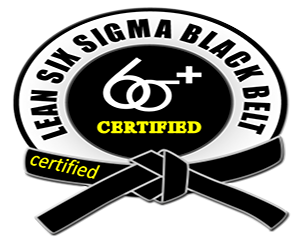Concept of SIX SIGMA Overview:
The Lean Six Sigma training helps in validating professionals who are skilled in identifying risks, errors, or defects in a business process and removing them. Getting a Six Sigma course & certification usually requires individuals to have a certain level of experience and testify their proficiency.
The certification can help you become a specialist in process improvement and will enhance your credibility.
Problem Solving Technique :
- This program can boost companies profit, rise productivity and quality.
- This program can help to do better time management and insure safety.
- Best and maximum productivity with less equipment and facilities.
Objective (why you should get a six sigma certification:):
- Help Your Organization Reduce Risk and Eliminate Errors and Defects.
- Improve Business Processes and Sustain Quality Improvement.
- Increase Your Value Across Industries.
- Ensure Compliance.
- Improve Management Skill.
About Black Belt:
A Certified Six Sigma Black Belt is an expert who can describe Six Sigma theories and principles, as well as enabling systems and tools.
A Black Belt should show team leadership, comprehend team dynamics, and assign duties and obligations to team members.
Who can Join Our Black Belt Course:
- Quality Manager
- Production manager
- Safety manager
- Finance manager
- Marketing manager
- Operation manager
- Project Engineers
- Production Engineers
- Quality Engineers
- Quality Analyst
Course Duration:
Mode of Learning
-
- Online
- Class Room
- Blended Mode
Lean Six Sigma Black Belt Course Content.Module 1: Define
Introduction to Six Sigma
• History of Six Sigma
• Need for Six Sigma
• Six Sigma metrics
• DMAIC (Define, Measure, Analyze, Improve, Control) methodology overview
• Examples of Six Sigma results
Voice of the customer (VOC)
CTx (quality, time, cost)
Converting VOC to CTQs (critical to quality)
SIPOC (supplier, input, process, output, customer)
Pareto analysis
Project charter
• Business opportunity
• Problem statement
• Objective primary and secondary metrics
• Scope
• Cost of poor quality (COPQ)
• Project teams
Stakeholder analysis
Module 2: Measure
Process mapping
Fishbone diagram
Graphical tools
• Histogram
• Dot plot
• Boxplot
• Scatterplot
• Time series plot
• Pareto chart
Basic statistics and probability
• Types of data
• Accuracy versus precision
• Mean, median, mode
• Range, interquartile range, variance, standard deviation
• Sample versus population
• Percentiles
• Central limit theorem
• Confidence intervals
Process distributions
• Normal distribution
• Exponential, Weibull, lognormal
• Binomial, Poisson
Lean concepts
• Value stream, flow
• Batch versus single-piece flow
• Seven forms of waste
• Push versus pull systems
• Kanbans, work cells
• Supply chain, just-in-time
• 5S (sort, straighten, shine, standardize, sustain) and visual management
• Standard work
• OEE (overall equipment effectiveness)
Sampling and data collection
• Sampling bias
• Sampling techniques: random, stratified random, systematic, rational subgrouping
• Power and sample size calculations
Process capability
• Process stability
• Normal capability analysis (Cp, Cpk, CPM, Pp, Ppk)
• Non-normal capability analysis
• Binomial and Poisson capability analysis
• Rolled throughput yield (RTY), defect per unit (DPU), defects per million opportunities (DPMO), S
igma level (including shift)
Measurement system analysis
• Variable gage R&R
• Destructive testing
• Crossed versus nested designs
• Attribute Gage R&R
Module 3 : Analyze
Failure mode and effects analysis (FMEA)
Multi-vari analysis
Inferential probability distributions
• Normal
• Chi-square
• True, False
• Binomial, Poisson
Hypothesis testing
• Anderson-Darling normality test
• One-sample t-test
• Two-sample t-test
• Paired t-test
• One-way analysis of variance (ANOVA)
• One-sample test for variation
• Two-sample test for variation
• Test for equal variance
• One-sample sign
• Mood’s median test
• One-proportion test
• Two-proportion test
• Chi-squared contingency table
• One-sample Poisson rate
• Two-sample Poisson rate
General ANOVA
Correlation and regression
Multiple regression
Binary logistic regression
Design of experiments (DOE) strategies
2k full factorial DOE
DOE center points, blocking, covariates
2k fractional factorial DOE
General full factorial DOE
Central composite design
Module 4: improve.
Innovative solutions (brainstorming, etc.)
Selecting a solution (Pugh matrix)
DOE multiple response optimization
Response surface methodology
Evolutionary operation (EVOP)
Lean tools
• Lean measures of time: lead time, takt time, completion time, cycle time
• Value stream mapping
• Time value mapping
• Theory of constraints
• Load charts/line balancing
• Spaghetti chart
Queuing theory
Improve techniques.
• Self-inspection
• Training
• Checklist
• Process simplification
• Mistake proofing
Implementation and verification (piloting, etc.)
Module 5: Control
Statistical process control
• I-MR charts
• Xbar-R charts
• Xbar-S charts
• P-charts
• C-charts
• U-charts
